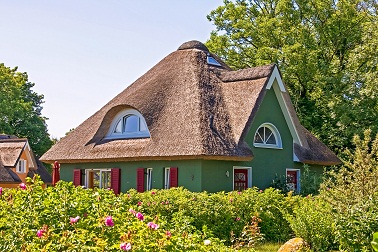
Do you need a new roof? Are you building a house and considering your roofing options? Many people assume that their options are limited; you either install shingles or a metal roof. The truth is there are many choices, including biomass roofing.
What is Biomass Roofing?
Biomass means that it’s made from natural materials. A great example, and a traditional one, is the thatch roof. Thatched roofs have been used for thousands of years. Traditionally they’re made from leaves, grasses, reeds, and straw. Of course today’s thatch options are a bit more sophisticated.
The Benefits of Biomass Roofing
Biomass roofing options are incredibly durable. In fact thatch roofs are said to last between 50 and 70 years. That’s significantly longer than traditional shingles. Biomass is often a fantastic insulator. They are also made from materials that are renewable, and when you have to replace your roof you don’t have to worry about filling up a landfill. Biomass is biodegradable. Biomass is also abundant and sustainable.
Downsides to Biomass Roofing?
There are some downsides to biomass options. In general, they’re not fireproof. Thatch roofs burn easily and quickly. However, you can treat the material with fire proofing and insect proofing to make sure your home is insurable and that it meets your living standards. This does affect its biodegradability.
Types of Biomass Roofing
As you’re exploring your roofing options you’ll want to look into the various types of biomass materials. They include but aren’t limited to:
- Grass thatch
- Palm thatch
- Wood tiles
- Roof sheets made from organic fibers
Of all these options the one that perhaps best simulates traditional roofing is the wood tiles. They’re made from renewable materials. They have a lifespan of about 50 years. And they look quite attractive. Additionally, you can choose from different sizes and thicknesses. Thick tiles are called wood shake. Thin tiles are called shingles. The wood tiles are flammable. Leaves and pine needles as well as other airborne materials tend to stick to wood tiles so you’ll need to clean your roof occasionally.
Biomass roofing isn’t anything new. However more and more home builders and contractors are becoming aware of the possibilities. The technology and manufacturing processes are improving as well. If you’re interested in making your home more environmentally friendly, consider using biomass materials for your roofing needs. They last five or more times longer than tar shingles, depending on the material, and they’re aesthetically appealing too.

